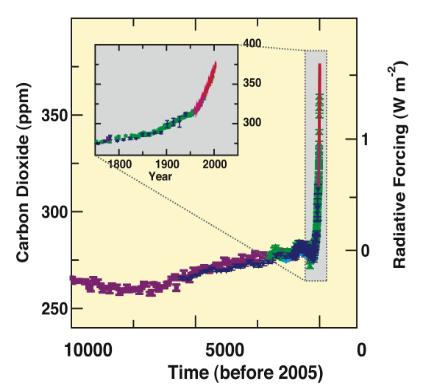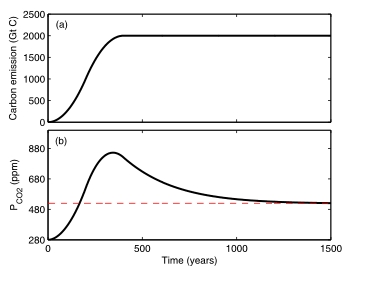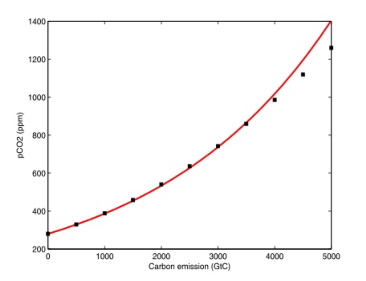Carbon cycling
|
Figure 1. Atmospheric concentrations of carbon dioxide over the last 10 000 years and since 1750 (inset panel). Measurements are shown from ice cores (coloured) and atmospheric samples (red lines). The corresponding radiative forcing is shown on the right-hand side. From the IPCC (2007).
|
|
Emissions of carbon dioxide (CO2) from fossil fuel combustion and land use changes are causing atmospheric CO2 concentrations to rise from a pre-industrial level of 277ppm to 379ppm in 2005 (IPCC, 2007a). This rise in atmospheric CO2, along with emissions of other greenhouse gasses, is leading to a net radiative heating of 1.67±0.17 Wm-2compared with the pre-industrial state. This anthropogenic forcing is predicted to disrupt the natural ecosystems and human populations alike over the next century (IPCC, 2007a):
|
Example of work at Liverpool
When carbon is emitted to the atmosphere, up to half the carbon dioxide is taken up by the oceans. Thus, directly connecting carbon emissions to the resulting atmospheric carbon dioxide concentrations is difficult to achieve, identifying this link usually involves integrating a climate model including the carbon cycle. We have identified how carbon emissions became partitioned between the atmosphere and ocean, consistent with a global air-sea equilibrium state being approached, where the stabilised partial pressure of CO2 is directly related to the amplitude of the carbon emissions (delta Iem) by an exponential relationship:

where IB is the buffered carbon inventory of the atmosphere and ocean. This response is illustrated in Figure 2 showing how the long term equilibrium state is controlled by the accumulated carbon emission, whatever the choice of emission scenario.
For further details, see Goodwin et al. (2007) and (2009).
|
Figure 2. A thought experiment identifying how atmospheric carbon dioxide adjusts over the next 1500 years for an emission scenario: (a) Accumulated emissions and (b) the resulting atmospheric CO2 concentrations (PCO2) over time using a 3 box ocean air-sea model. The final atmospheric CO2concentration is set by the accumulated carbon emission (red dashed line in (b)). From Goodwin (2007), PhD thesis.
|
|
Figure 3. The long-term equilibrated atmospheric CO2 concentration versus carbon emission. The atmospheric concentration increases exponentially with the carbon emissions (red line) based on analytical theory, which is supported by 11 independent MIT general circulation model experiments with different carbon emissions (Goodwin et al., 2007).
|
Presentation in the Marine Sciences Symposium 2008
Climate change: the science and the impacts - a Liverpool perspective by Phil Goodwin on "Climate forcing from carbon emissions"
References (and links)
- Goodwin, P., R.G. Williams, M.J. Follows and S. Dutkiewicz, 2007: Ocean-atmosphere partitioning of anthropogenic carbon dioxide on centennial timescales. Global Biogeochemical Cycles, 21, GB1014, doi:10.1029/GB002810.
- Goodwin, P., R.G. Williams, A. Ridgewell and M.J. Follows, 2009. Climate sensitivity to the carbon cycle modulated by past and future changes in ocean chemistry. Nature Geosciences, doi:10.1038/ngeo416.
- IPCC, Climate change 2007: The Physical Science Basis. Contribution of Working group I to the Fourth Assessment Report of the Intergovernmental Panel on Climate Change, Cambridge University Press, Cambridge, UK and New York, USA, 2007a.
- IPCC, Climate change 2007: Mitigation. Contribution of Working group III to the Fourth Assessment Report of the Intergovernmental Panel on Climate Change, Cambridge University Press, Cambridge, UK and New York, USA, 2007b.
- Subramaniam, A., Yager, P. L., Carpenter, E. J., Mahaffey, C.,Björkman, K., Cooley, S., Montoya, J. P., Sañudo-Wilhelmy, S. A., Shipe, R., and Capone, D. G., 2008. Amazon River enhances diazotrophy and carbon sequestration in the tropical North Atlantic Ocean. Proceedings of National Academy of Sciences, 105, 30, 10460-10465.
- Royal Society, Ocean acidification due to increasing atmospheric carbon dioxide, Policy Document 12/05, 2005


